Family : Sturnidae

Text © Dr. Gianfranco Colombo

English translation by Mario Beltramini

Here is the guilty. Sturnus vulgaris, destroyer of orchards covering monuments, cars and city roads of slippery guano, vehicle of infections © Gianfranco Colombo
They did try them all to drive away these intruders from our cities and from our cultivated fields. Smoking processes, cackles, bangers and powerful outburstsbut also peregrine falconsand other falconry raptors. By sure we have not yet arrived to adopt what has been done some years ago by the Gloucestershire Airport in England to free the airport runway from the birds that is spreading at full volume the music of rockstar Tina Turner.

It is often sedentary, but on the first cold the north populations migrate in mass with impressive flocks of thousands of individuals © Gianfranco Colombo
They say that it was heard from far away and that not all did love this type of music but looking back if applied to the agriculture it might transform in a pleasant diversion for the farmers working in the fields. Nevertheless, some cities are unable to get rid of them and suffer heavy and continuous damages due to the huge quantity of excreta that hundreds of thousands of birds produce during the hours of night perching.
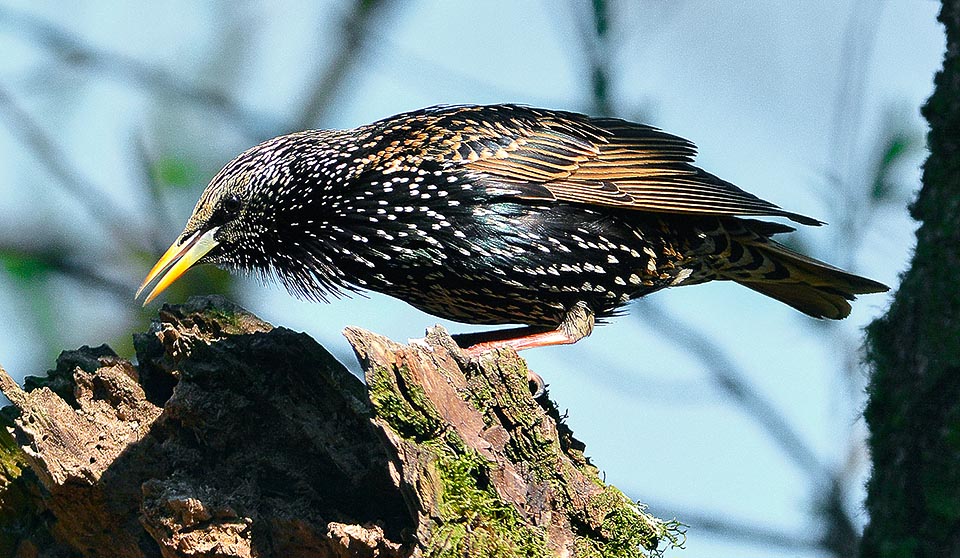
Native to Eurasia it has diffused in almost all the world, but South America and lands close to poles. One of the 100 species of animals more invasive and harmful of planet © Alvaro Dellera
In the cultivated countries the problem appears under the aspect of damages to the cultivations even if the incredible quantity of insects that they are able to catch, partly repays the damages it causes to orchards, vineyards and olive groves during the ripening of their fruits. Colourful pinwheels moved by the wind, flapping tinfoil strips hanging from the upper branches, clinking sheets and cans, then attempts of spilling oils and essence having an un pleasant taste for them, nothing to do.
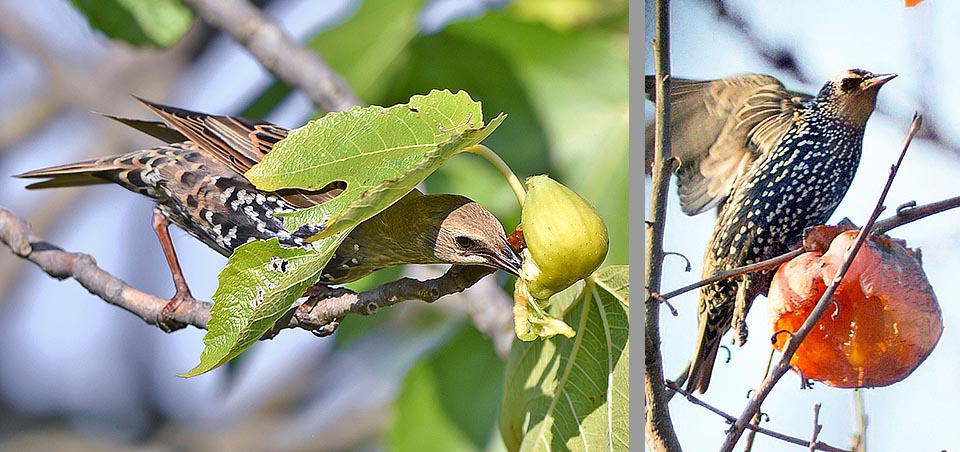
Here active in the home orchards. Olive groves and vineyards stand among the most affected and even if eats many insects the agricultural balance is surely in red © Agostino Codazzi © Gianfranco Colombo
It is sufficient the arrival of a small flock on a fruit-laden cherry tree that in a very short time the same is completely despoiled. Is fought the same battle that breeders and farmers daily sustain in all Europe against the ubiquitous Rock doves (Columba livia) or the Coypu (Myocastor coypus). Useless battles that do not find now any solution.

The starling gets nice looking for the reproduction. The black turns dominant with longer nuptial feahers, almost filiform, with bronze greenish metallic reflections © Gianfranco Colombo
The European starling or Common starling or simply Starling (Sturnus vulgaris Linnaeus, 1758) belongs to the order of the Passeriformes and to the family of the Sturnidae and together with the Spotless starling (Sturnus unicolor) and the Rosy starling (Sturnus roseus), is one of the three congeners present in Europe.
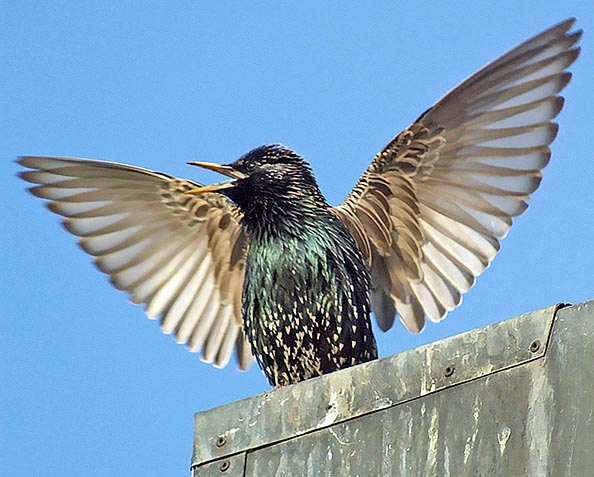
Then bangs crazily the wings to be noted in the group © Agostino Codazzi
Among the 100 animal species considered the most invasive and harmful in the world, three are small birds, the ill-famed and well known Red-vented bulbul (Pycnonotus cafer) and coincidentally, two sturnids: our European starling and the Common mina (Acridotheres tristis).
The man’s hand and his foolish experiments to introduce alien species in new territories for fighting other natural evils has helped almost always in causing damages much bigger than those the was trying to limit.
So it has been also for Sturnus vulgaris present in many parts of the world but guest now unwanted due to its prolificacy, adaptability and invasivity.
In USA, the species was introduced by the end of the XIX century in New York at the Central Park and immediately adapted to its new habitat, so much to rapidly diffuse in all North America and reappearing, as happened in the origin sites, as unsolvable and dramatic problem.
Of the 60 specimens released into the wild we count nowadays about 150 millions of them!
In these new environments it has found extremely easy to conquer a specific niche, at the expense of other autochthonous species that have been sent away from their atavistic territories or at least threatened on their own range.

The bill turns yellow. The iris is light brown-grey in the females and deep brown in males © G. Colombo
The scientific binomen gets its origin from the Latin “sturnus” = starling, spotted and “vulgaris” = common.
In English it is called Common Starling, in German Star, in Spanish Estornino Pinto, in French Étourneau sansonnet, in Portuguese Estorninho-malhado, in Italian Storno comune, Storno europeo or Stornello and in Japanaese Hoshimukudori.
Zoogeography
The range of Sturnus vulgaris is extremely vast if we include the areas where it has been introduced. It practically occupies all continents but South America (even if introduced in Argentina where it is scarcely present and in the Falkland Islands) and, of course, Antarctica.
Europe is the original range, totally occupied, and Asia up to the Central Asian republics with northern limit with the tundra and south the Indian plains.
It also occupies the Mediterranean coasts of Morocco, Algeria and of Tunisia and the islands of Macaronesia.
Conversely it has been introduced and is now stabilized since decades, in North America up to Mexico, in South Africa and in Australia.
The starling is a typical sedentary species in the temperate territories whilst is migratory in the northernmost ranges from where, at the approach of the bad season, it moves to the southern quarters decupling the population permanently installed.
It is in these locations that Sturnus vulgaris causes the biggest damages rightly due to the exorbitant number of the concentrations and the insistence on limited territories.
Nevertheless, even if knowing the very considerable damages it causes to agriculture and to the public health, some nations, among which Italy, in a more political than naturalistic evaluation, considers it as a protected species and forbids its hunt and contrast. Big cities like Rome and partly also Milan are practically under siege in winter and during the night can be seen paralyzed and rendered uninhabitable whole districts chosen as dorms by these immense flocks.

For settling the European starling (Sturnus vulgaris) seeks often, like here, a woodpecker abandoned nest, but is good also the big crack of a building or a small hole under the tile © Gianfranco Colombo
Tens of thousands of these birds gather on the trees that skirt these avenues depositing a so much high quantity of excreta to cause damage to monuments, cars recklessly parked and to render so much slippery the roads to render difficult the walking or the passing through with the cars.
The cost of sanitation is high for the community and the discomfort to the inhabitants affected by the problem are unacceptable for the dirt as well as for the night noise to which they are submitted.
However, the exasperated concept, expressed in any case by few, of a blind and misinterpreted protectionism, hinders the application of suitable remedies.
Recent studies have evidenced the danger of these dejections that can spread parasitical and bacterial diseases. Who knows if this fear can stir the “scientific” minds of those advocates “at all costs”.
Ecology-Habitat
Sturnus vulgaris has adapted perfectly to any ambient situation, even changing its own passeriform habits.
If the treed environments were essential part for their presence, now they have been replaced by the masonry constructions inside an overcrowded city as well as isolated farmhouses.
If for necessity of nidification were essential holes and openings in the trees or on the roofs, in the North Sea islands, totally devoid of vegetation, they have adapted to nest in holes on the ground or in the dry stone walls.
Natural habitat are the cultivated areas with extensive grass cover, with cereals, with frequent irrigation, disseminated with animal farms or untamed pastures. In the vast European continental plains they love the lines of trees surrounded by ample free spaces where they can go around looking perpetually for food.

Sturnus vulgaris nidifies even thrice a year with 5-7 eggs, evenly light blue, brooded alternately by parents for 2 weeks © Gianfranco Colombo
They also live in the cities even if they prefer peripheral or country towns where they find their ideal habitat where to spend their life. They do not frequent the dense thickets, the forests and neither the high mountains.
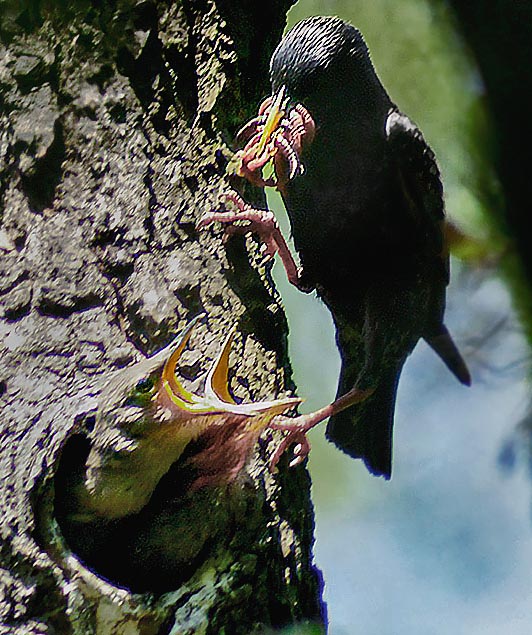
Imploring mouths. A bottomless stomach needing proteins © Agostino Codazzi
Morfofisiologia
Morpho-physiology (Turdus merula), a bird totally black when seen, even if, when closer, it shows a more varied colouration. It has two typical seasonal liveries, always linked to this colour.
The reproductive one where the black colour becomes dominant on the whole plumage spreading in the upper part to cover it totally, leaving only the alar cover and the lower abdomen with white dots regularly disseminated.
These nuptial feathers, more elongated and filiform, have very characteristic greenish bronze metallic reflections that give colour to the customary and lugubrious black they are normally adorned with.
Conversely, the post-reproductive livery is completely black but with strong dots all over the body. Also the bill becomes black and the legs darken significantly.
On the contrary, the juveniles have a more brownish look but soon they will get the typical white on black background dotting that will cover, in a few months, the whole plumage.
There is not evident dimorphism between the sexes even if at times the male shows a spot at the base of the bill of light blue colour whilst the same is brownish pink in the females.
The best way for determining with certainty the sex of this bird is the colour of the iris. Light brown or grey in the female and deep brown in the male.
Sturnus vulgaris is 23 cm long, the wingspan is of about 35 cm and the weight 80 g. Various subspecies have been determined in the whole world and others are still now under discussion seen the possibility for the neighbouring subspecies to hybridize between them.

When 3 weeks old the young leave the nest with their typical brown livery. They merge at once in numerous bands ready for squabbles for a bite © Gianfranco Colombo
The starling has an innate ability of imitating the song of other birds. It is already a highly talkative bird and in any season it emits songs and calls having a social purpose and also a farraginous song when it defends its territory. We often see it from our balconies on the aerials of the facing houses, shaking wildly the wings as if it was taken by a nervous tremor and emitting that hard to describe shrill warble that is its territorial song.
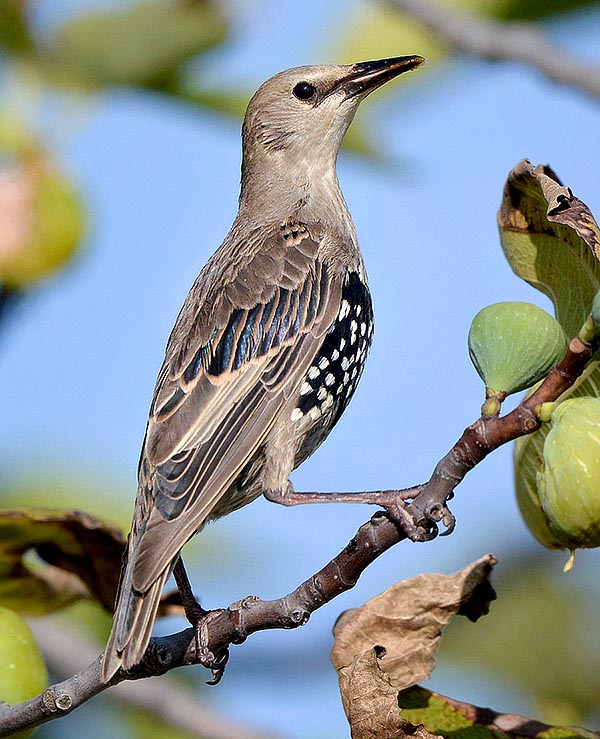
By end of season they get slowly the typical dotting of the adults.
Seen the high sociality it does not have that open aggressiveness towards it similars, on the contrary, it tolerates them without any problem seen that it allows them to do the same sport a very few metres far away, on the nearby aerial.
Sturnus vulgaris is able to imitate many birds and even domestic noises, from the Atlantic canary (Serinus canaria) kept in the cage on the balcony of the neighbour, to the Swallow (Hirundo rustica), from the House martin (Delichon urbica) to the crockery banging or the noise of the fall of objects but with great skill is able to imitate also the song of the Golden oriole (Oriolus oriolus) and of the Common quail (Coturnix coturnix), African summer visitors of our continent.
They cause in the ornithologists that spring wince off season for having heard those songs so much familiar as well as still far to come.
But now they know well that the starling makes fun of them!
The starling can be mistaken with the blackbird but only for the common blackish colour of their liveries. The social behavior, the morphology and the flight are extremely different.
The blackbird when on the ground mostly hops whilst the starling walks incessantly.
The blackbird is famous for the yellow bill, robust and well evident, the starling has the same of that colour only in summer and the same is hooked and sharp.
Very rarely the starling moves alone but is always in group, at times in immense flocks, thing that the blackbird abhors being a typically solitary species.
Ethology-Reproductive Biology
Sturnus vulgaris is a very prolific bird and with an excellent reproductive success seen the great sociability of the species and the high adaptability to any situation.

By end of season they get slowly the typical dotting of the adults © Gianfranco Colombo
In favourable conditions, it normally nidifies three times, with broods of 4-6 chicks.
The nest is placed in holes of trees, using old nests of woodpeckers, in cracks of the walls, under the tiles, in nest boxes and as said before, on the ground or in the dry stone walls where suitable shelters are not available.
The nest is a shapeless mass of dry grass lined inside of feathers and animal hairs, where are laid eggs of a nice uniform light blue colour.
The eggs are brooded for about fifteen days by both partners and the chicks, who come to life blind and featherless, stay in the nest for about three weeks more.
Some days after the first flight the young are already autonomous and join those summer bands, very numerous and wandering, mainly formed by immatures and some adults.
Sturnus vulgaris is occasionally subject to intraspecific parasitism. Some females despite having their own nest, lay the eggs in that of other starlings without any particular reason.
The starling is usually an insectivorous species and consumes a very huge quantity of insects but during the autumn and the winter turns almost exclusively frugivorous causing those damage we were previously talking of.
Olive groves orchards and vineyards are the main targets of their raids, cultivations invaded by flocks impressive at times that cause enormous damages.
Also sowings are subject to this massacre and useless have been the measures taken for limiting the damages.
The starling has several predators in nature, from the small day and night raptors, to rodents and mustelids but their number does surely not suffer from these small takings.

The yellow of the bill gradually disappears, the fruits lack and they await spring shivering, one close to the other, as in this sad tv meeting © Gianfranco Colombo
The most insidious enemies remain some parasites such as fleas and mallophagous insects that often invade the nest destroyng the entire brood.
Since 2018, Sturnus vulgaris appears as “LC, Least Concern”, in the IUCN Red List of endangered species.
→ To appreciate the biodiversity within PASSERIFORMES please click here.
